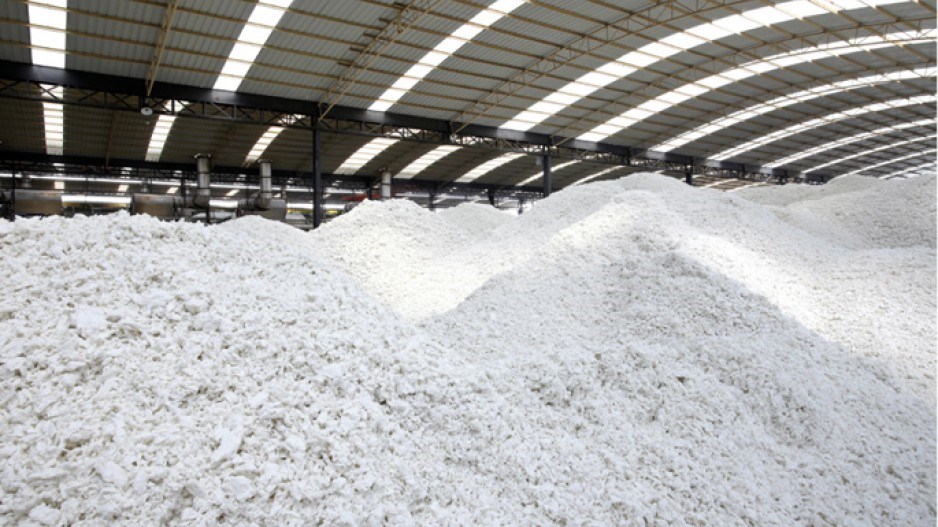At Canfor Pulp's (TSX:CFX) Burnaby innovation centre, director of research Paul Watson holds up a handful of tiny sheets of pulp, each one no more than a few centimetres square.
They have been cut by a customer in Japan from larger sheets that make up a bale of pulp, part of a specialty order produced at one of Canfor's three Prince George mills. On each piece, someone has drawn a small circle in blue ink.
Within the circle, there is a defect, a tiny speck or bump, imperceptible to the human eye.
Canfor produces 1.2 million tonnes of northern bleached softwood kraft pulp a year. It's mostly used in packaging and paper and tissue manufacturing.
But as the demand for renewable products grows, new applications are emerging for B.C. pulp that are piquing Watson's interest.
“We are right on the edge of the research world and the production world,” he said. “We are spanning that gap where we are taking the information, technologies and interesting opportunities and trying to apply them in a commercial sense.”
The Canadian pulp industry is entering a new chapter as it seeks to extract and find applications for the basic building blocks of wood fibre itself. At a recent nanotechnology conference in Vancouver, Geoff Clarke, vice-president of corporate planning at Alberta-Pacific Forest Industries, said the industry is learning from the experience of oil refineries.
Only 4% of a barrel of oil goes into chemicals and plastics, but that 4% produces 42% of the revenue, he said. A small portion of the wood fibre that pulp mills use can produce larger returns if markets for these new products can be developed.
And with new low-cost super-sized pulp mills now coming on stream in the Southern Hemisphere, the fate of the Canadian industry, Clarke said, “is very obvious” if it doesn't find new sources of revenue.
He added that putting the pieces of the transformation puzzle together remains a challenge. There will be no single solution.
“There will be no home runs, but there appear to be singles, possibly doubles.”
Canfor is working on hitting singles: products that differentiate its pulp from competitors and for which there is a market.
The customer in Japan, who in turn is working under contract to produce a new product for one of the world's major smartphone manufacturers, is seeking perfection in the bales of pulp it buys from Canfor. It's designing a touch screen for the next generation of smartphones that will be no more than two cellulose fibres thick. Because it is thinner than current plastic screens, it will be more sensitive to the touch and have the added cachet of being made from a renewable product rather than fossil-fuel-based plastic.
Any flaw in the pulp sheets they use, even if it takes a magnifying glass to spot it, is sent back to Canada.
“They want very clean pulp. If there is any defect at all, the end product is ruined,” Watson said. “They go through every single sheet in every single bale, cut out what is basically a defect and send it to us saying, ‘What is it? And what are you doing to fix it?' As is their prerogative.”
The samples are put through a battery of tests to isolate the cause of the imperfections. Quality-control systems are then designed to make certain the issue is dealt with.
It's one of the more exciting applications of pulp from B.C. forests for the 12 people who staff the innovation centre. They are part of a larger collaboration involving industry, academia and government agencies working to make new products from what many view as the best fibre resource in the world: pulp made from Canada's slow-growing northern forests.
Ironically, much of the push for quality in pulp and new applications for fibre is a direct result of the mountain pine beetle's impact on Interior forests. Just as lumber companies had to invest in new technologies to mill beetle-killed wood, the pulp industry is investing in quality control.
Customers are aware of the impact the beetle has had on lumber and are inquiring about any impact on the quality of pulp.
Canfor Pulp has responded by investing $9.5 million in a suite of technologies it calls Mihari, the Japanese word for watch guard, that measures product quality throughout the entire manufacturing process. It includes sophisticated scanning systems that can measure the thickness of cell fibre walls.
As a result, said Watson, the pulp-maker can provide detailed information to customers on quality. Better monitoring of quality has opened the door to new applications, such as the touch screen.
Canfor is also working with the new suppliers in the Southern Hemisphere to incorporate the high quality associated with northern pulp in their product, while using less of it in the final mix.
Assisting customers in using less of your product might seem counterproductive, Watson said, but it helps keep their costs down, and in the highly competitive world of pulp markets, cost is key.
Further, demand for tissue products is rising. The developing world not only wants tissue, it wants softer, stronger tissue, and that's achieved by adding northern bleached softwood kraft to the mix.
“We have a wonderful fibre endowment here in British Columbia,” Watson said, “and we sell our product to those customers who really can take advantage of the very high strength that we have as a consequence of the species and growing conditions in central British Columbia. These are very fine-fibred pulps. There is a very high number of fibres per tonne, and you get an exceptional reinforcement as a consequence of that.
“That absolutely plays to our advantage. If we can become their fibre of choice, it puts us in a brilliant position.”




